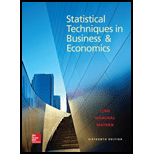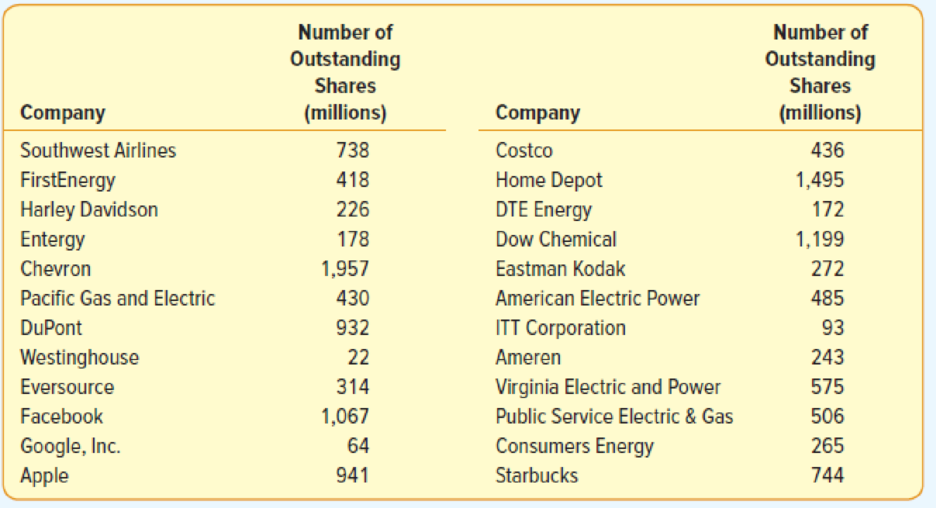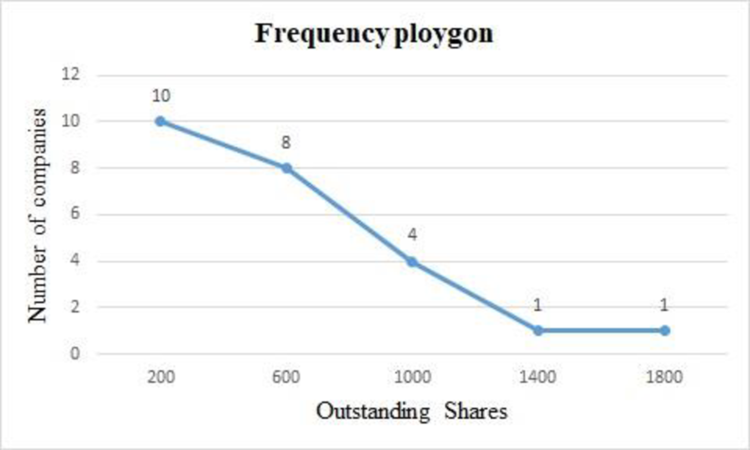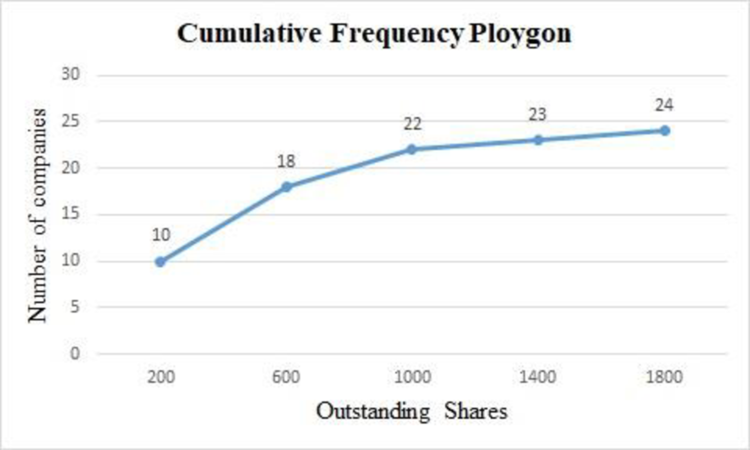
Concept explainers
The numbers of outstanding shares for 24 publicly traded companies are listed in the following table.

- a. Using the number of outstanding shares, summarize the companies with a frequency distribution.
- b. Display the frequency distribution with a frequency
polygon . - c. Create a cumulative frequency distribution of the outstanding shares.
- d. Display the cumulative frequency distribution with a cumulative frequency polygon.
- e. Based on the cumulative relative frequency distribution, 75% of the companies have less than “what number” of outstanding shares?
- f. Write a brief analysis of this group of companies based on your statistical summaries of “number of outstanding shares.”
a.
Construct a frequency distribution for the given table.
Answer to Problem 38CE
The frequency distribution for the publicly traded companies is given below:
| Outstanding shares |
Number of companies |
| 0–400 | 10 |
| 400–800 | 8 |
| 800–1,200 | 4 |
| 1,200–1,600 | 1 |
| 1,600–2,000 | 1 |
| Total | 24 |
Explanation of Solution
Selection of number of classes:
The “2 to the k rule” suggests that the number of classes is the smallest value of k, where
It is given that the data set consists of 24 observations. The value of k can be obtained as follows:
Here,
Therefore, the number of classes for the given data set is 5.
From the given data set, the maximum and minimum values are 1,957 and 22, respectively.
The formula for the class interval is given as follows:
where i is the class interval and k is the number of classes.
Therefore, the class interval for the given data can be obtained as follows:
In practice, the class interval size is usually rounded up to some convenient number. Therefore, the reasonable class interval is 400.
Frequency distribution:
The frequency table is a collection of mutually exclusive and exhaustive classes, which shows the number of observations in each class.
Since the minimum value is 22 and the class interval is 400, the first class would be 0–400. The frequency distribution for the publicly traded companies can be constructed as follows:
| Outstanding shares |
Number of companies |
| 0–400 | 10 |
| 400–800 | 8 |
| 800–1,200 | 4 |
| 1,200–1,600 | 1 |
| 1,600–2,000 | 1 |
| Total | 24 |
b.
Create a frequency polygon for the frequency distribution.
Answer to Problem 38CE
The frequency polygon for the given data is as follows:

Explanation of Solution
For the given data set, the frequency table with mid-points of classes is obtained as follows:
| Outstanding shares | Mid-point |
Number of companies |
| 0–400 | 10 | |
| 400–800 | 8 | |
| 800–1,200 | 4 | |
| 1,200–1,600 | 1 | |
| 1,600–2,000 | 1 | |
| Total | 24 |
The frequency polygon for the given data can be drawn using EXCEL.
Step-by-step procedure to obtain the frequency polygon using EXCEL:
- Enter the column of midpoints along with the frequency column.
- Select the total data range with labels.
- Go to Insert > Charts > line chart.
- Select the appropriate line chart.
- Click OK.
c.
Create a cumulative frequency distribution for the given table.
Answer to Problem 38CE
The cumulative frequency distribution is given below:
| Outstanding shares |
Number of companies |
Cumulative frequency |
| 0–400 | 10 | 10 |
| 400–800 | 8 | 18 |
| 800–1,200 | 4 | 22 |
| 1,200–1,600 | 1 | 23 |
| 1,600–2,000 | 1 | 24 |
| Total | 24 |
Explanation of Solution
The cumulative frequency distribution for the frequency table in Part (a) can be constructed as follows:
| Outstanding shares |
Number of companies |
Cumulative frequency |
| 0–400 | 10 | 10 |
| 400–800 | 8 | |
| 800–1,200 | 4 | |
| 1,200–1,600 | 1 | |
| 1,600–2,000 | 1 | |
| Total | 24 |
d.
Create a cumulative frequency polygon for the frequency distribution.
Answer to Problem 38CE
The cumulative frequency polygon for the given data is as follows:

Explanation of Solution
For the given data set, the cumulative frequency table with mid-points of classes is obtained as follows:
| Outstanding shares | Mid-point |
Cumulative frequency for Number of companies |
| 0–400 | 10 | |
| 400–800 | 18 | |
| 800–1,200 | 22 | |
| 1,200–1,600 | 23 | |
| 1,600–2,000 | 24 |
The cumulative frequency polygon for the given data can be drawn using EXCEL.
Step-by-step procedure to obtain the frequency polygon using EXCEL:
- Enter the column of midpoints along with the cumulative frequency column.
- Select the total data range with labels.
- Go to Insert > Charts > line chart.
- Select the appropriate line chart.
- Click OK.
e.
Find the number of outstanding shares that 75% of the companies have below than it.
Answer to Problem 38CE
Approximately 75% of the companies have less than 600 outstanding shares.
Explanation of Solution
75% of the total 24 companies are 18 companies. From the given cumulative frequency polygon, the value on the outstanding shares axis corresponding to 18 on the number of companies’ axis is 600. Therefore, approximately 75% of the companies have less than 600 outstanding shares.
f.
Give an explanation about the analysis of the number of outstanding shares.
Explanation of Solution
From the cumulative frequency distribution in Part (d), 18 out of 24 companies have less than 600 million shares. Only 2 companies have more than 1200 million shares. Thus, the distribution of number of outstanding shares is positively skewed.
Want to see more full solutions like this?
Chapter 2 Solutions
Statistical Techniques in Business and Economics
- Please answer the questionsarrow_forward30. An individual who has automobile insurance from a certain company is randomly selected. Let Y be the num- ber of moving violations for which the individual was cited during the last 3 years. The pmf of Y isy | 1 2 4 8 16p(y) | .05 .10 .35 .40 .10 a.Compute E(Y).b. Suppose an individual with Y violations incurs a surcharge of $100Y^2. Calculate the expected amount of the surcharge.arrow_forward24. An insurance company offers its policyholders a num- ber of different premium payment options. For a ran- domly selected policyholder, let X = the number of months between successive payments. The cdf of X is as follows: F(x)=0.00 : x < 10.30 : 1≤x<30.40 : 3≤ x < 40.45 : 4≤ x <60.60 : 6≤ x < 121.00 : 12≤ x a. What is the pmf of X?b. Using just the cdf, compute P(3≤ X ≤6) and P(4≤ X).arrow_forward
- 59. At a certain gas station, 40% of the customers use regular gas (A1), 35% use plus gas (A2), and 25% use premium (A3). Of those customers using regular gas, only 30% fill their tanks (event B). Of those customers using plus, 60% fill their tanks, whereas of those using premium, 50% fill their tanks.a. What is the probability that the next customer will request plus gas and fill the tank (A2 B)?b. What is the probability that the next customer fills the tank?c. If the next customer fills the tank, what is the probability that regular gas is requested? Plus? Premium?arrow_forward38. Possible values of X, the number of components in a system submitted for repair that must be replaced, are 1, 2, 3, and 4 with corresponding probabilities .15, .35, .35, and .15, respectively. a. Calculate E(X) and then E(5 - X).b. Would the repair facility be better off charging a flat fee of $75 or else the amount $[150/(5 - X)]? [Note: It is not generally true that E(c/Y) = c/E(Y).]arrow_forward74. The proportions of blood phenotypes in the U.S. popula- tion are as follows:A B AB O .40 .11 .04 .45 Assuming that the phenotypes of two randomly selected individuals are independent of one another, what is the probability that both phenotypes are O? What is the probability that the phenotypes of two randomly selected individuals match?arrow_forward
- 53. A certain shop repairs both audio and video compo- nents. Let A denote the event that the next component brought in for repair is an audio component, and let B be the event that the next component is a compact disc player (so the event B is contained in A). Suppose that P(A) = .6 and P(B) = .05. What is P(BA)?arrow_forward26. A certain system can experience three different types of defects. Let A;(i = 1,2,3) denote the event that the sys- tem has a defect of type i. Suppose thatP(A1) = .12 P(A) = .07 P(A) = .05P(A, U A2) = .13P(A, U A3) = .14P(A2 U A3) = .10P(A, A2 A3) = .011Rshelfa. What is the probability that the system does not havea type 1 defect?b. What is the probability that the system has both type 1 and type 2 defects?c. What is the probability that the system has both type 1 and type 2 defects but not a type 3 defect? d. What is the probability that the system has at most two of these defects?arrow_forwardThe following are suggested designs for group sequential studies. Using PROCSEQDESIGN, provide the following for the design O’Brien Fleming and Pocock.• The critical boundary values for each analysis of the data• The expected sample sizes at each interim analysisAssume the standardized Z score method for calculating boundaries.Investigators are evaluating the success rate of a novel drug for treating a certain type ofbacterial wound infection. Since no existing treatment exists, they have planned a one-armstudy. They wish to test whether the success rate of the drug is better than 50%, whichthey have defined as the null success rate. Preliminary testing has estimated the successrate of the drug at 55%. The investigators are eager to get the drug into production andwould like to plan for 9 interim analyses (10 analyzes in total) of the data. Assume thesignificance level is 5% and power is 90%.Besides, draw a combined boundary plot (OBF, POC, and HP)arrow_forward
- Please provide the solution for the attached image in detailed.arrow_forward20 km, because GISS Worksheet 10 Jesse runs a small business selling and delivering mealie meal to the spaza shops. He charges a fixed rate of R80, 00 for delivery and then R15, 50 for each packet of mealle meal he delivers. The table below helps him to calculate what to charge his customers. 10 20 30 40 50 Packets of mealie meal (m) Total costs in Rands 80 235 390 545 700 855 (c) 10.1. Define the following terms: 10.1.1. Independent Variables 10.1.2. Dependent Variables 10.2. 10.3. 10.4. 10.5. Determine the independent and dependent variables. Are the variables in this scenario discrete or continuous values? Explain What shape do you expect the graph to be? Why? Draw a graph on the graph provided to represent the information in the table above. TOTAL COST OF PACKETS OF MEALIE MEAL 900 800 700 600 COST (R) 500 400 300 200 100 0 10 20 30 40 60 NUMBER OF PACKETS OF MEALIE MEALarrow_forwardLet X be a random variable with support SX = {−3, 0.5, 3, −2.5, 3.5}. Part ofits probability mass function (PMF) is given bypX(−3) = 0.15, pX(−2.5) = 0.3, pX(3) = 0.2, pX(3.5) = 0.15.(a) Find pX(0.5).(b) Find the cumulative distribution function (CDF), FX(x), of X.1(c) Sketch the graph of FX(x).arrow_forward
 Holt Mcdougal Larson Pre-algebra: Student Edition...AlgebraISBN:9780547587776Author:HOLT MCDOUGALPublisher:HOLT MCDOUGAL
Holt Mcdougal Larson Pre-algebra: Student Edition...AlgebraISBN:9780547587776Author:HOLT MCDOUGALPublisher:HOLT MCDOUGAL Glencoe Algebra 1, Student Edition, 9780079039897...AlgebraISBN:9780079039897Author:CarterPublisher:McGraw Hill
Glencoe Algebra 1, Student Edition, 9780079039897...AlgebraISBN:9780079039897Author:CarterPublisher:McGraw Hill Big Ideas Math A Bridge To Success Algebra 1: Stu...AlgebraISBN:9781680331141Author:HOUGHTON MIFFLIN HARCOURTPublisher:Houghton Mifflin Harcourt
Big Ideas Math A Bridge To Success Algebra 1: Stu...AlgebraISBN:9781680331141Author:HOUGHTON MIFFLIN HARCOURTPublisher:Houghton Mifflin Harcourt Trigonometry (MindTap Course List)TrigonometryISBN:9781305652224Author:Charles P. McKeague, Mark D. TurnerPublisher:Cengage Learning
Trigonometry (MindTap Course List)TrigonometryISBN:9781305652224Author:Charles P. McKeague, Mark D. TurnerPublisher:Cengage Learning College Algebra (MindTap Course List)AlgebraISBN:9781305652231Author:R. David Gustafson, Jeff HughesPublisher:Cengage Learning
College Algebra (MindTap Course List)AlgebraISBN:9781305652231Author:R. David Gustafson, Jeff HughesPublisher:Cengage Learning Functions and Change: A Modeling Approach to Coll...AlgebraISBN:9781337111348Author:Bruce Crauder, Benny Evans, Alan NoellPublisher:Cengage Learning
Functions and Change: A Modeling Approach to Coll...AlgebraISBN:9781337111348Author:Bruce Crauder, Benny Evans, Alan NoellPublisher:Cengage Learning





